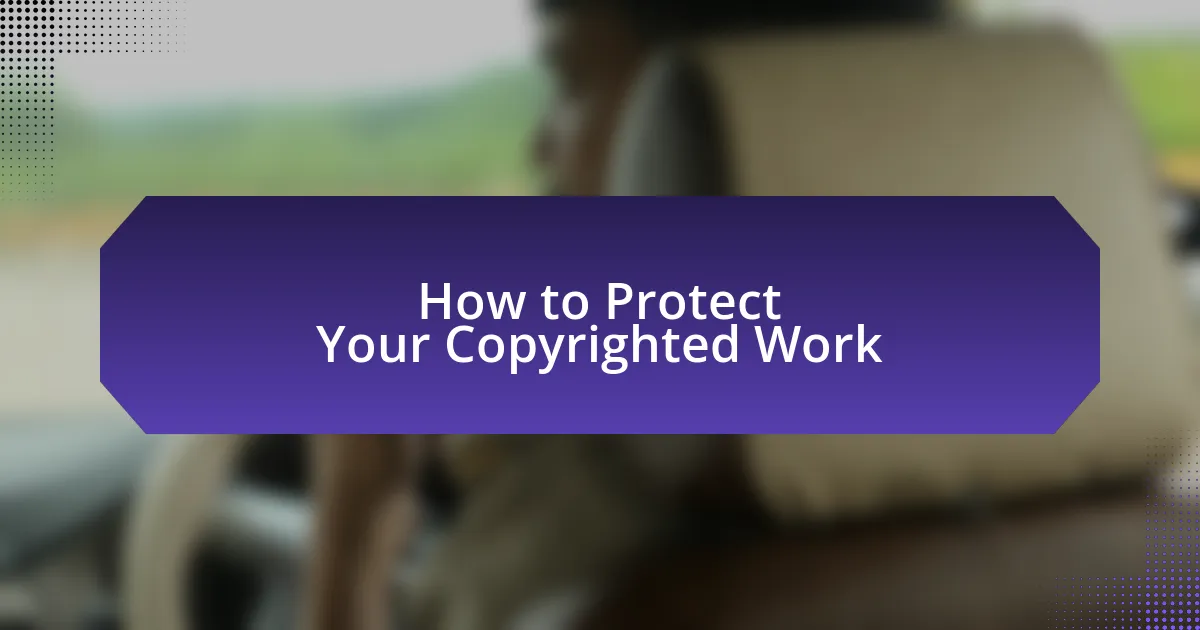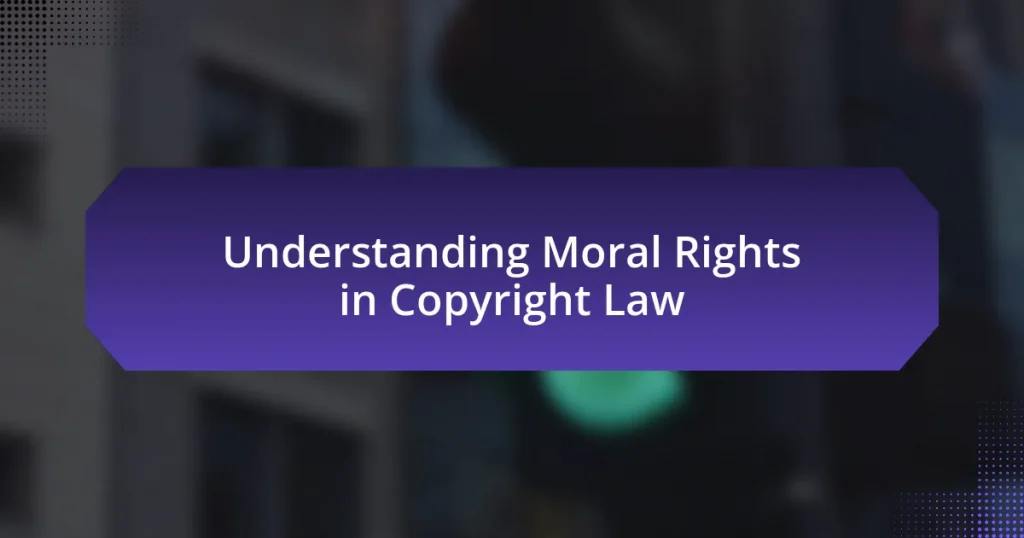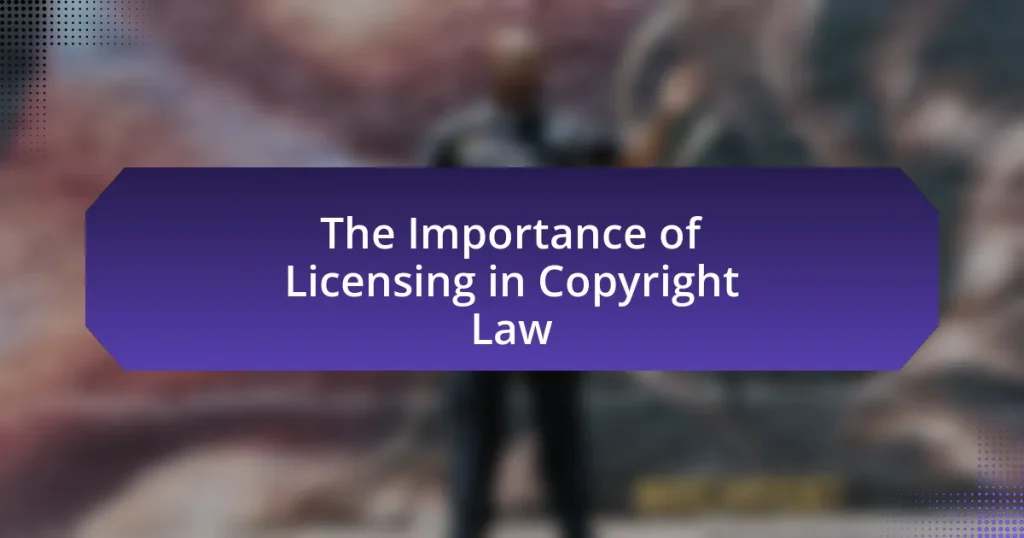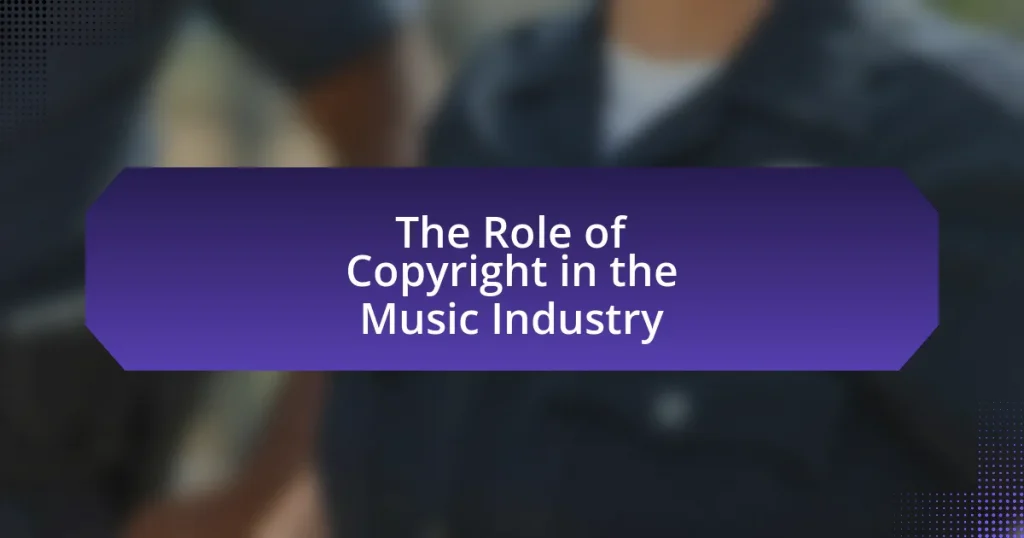Copyright is a legal protection that grants creators exclusive rights to their original works, including literature, music, and art, incentivizing creativity and innovation. This article outlines the importance of copyright, the types of works eligible for protection, and the duration of copyright coverage. It also details the consequences of copyright infringement, legal actions available to creators, and best practices for protecting copyrighted work, including registration, monitoring, and licensing agreements. Additionally, the article discusses the role of technology in safeguarding intellectual property and provides resources for further education on copyright laws.
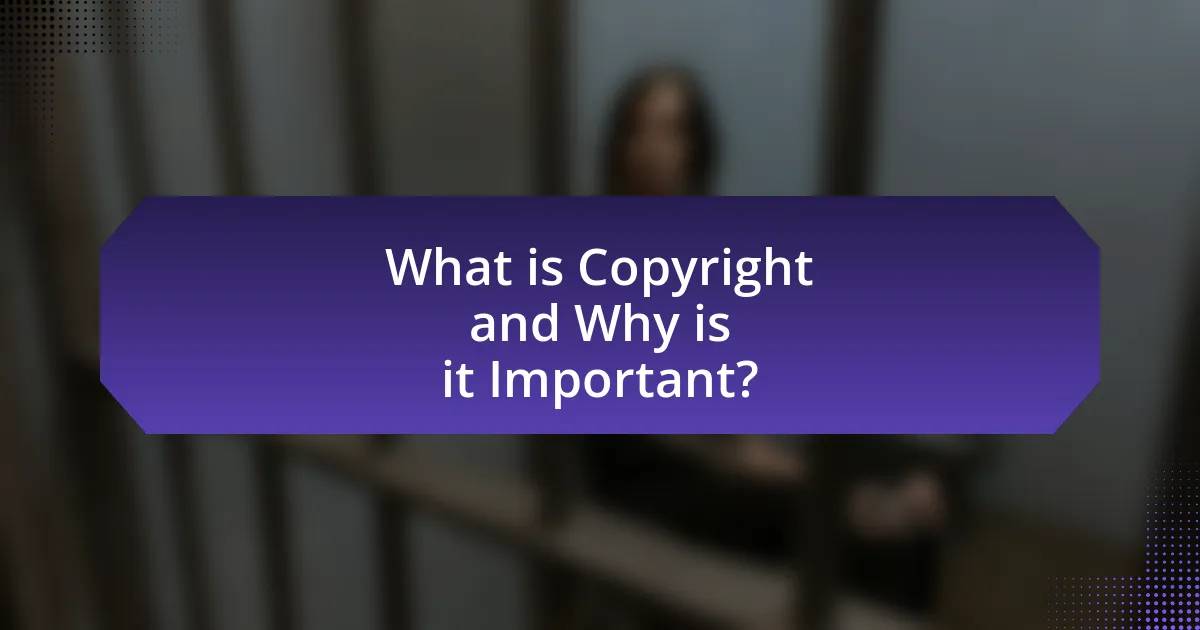
What is Copyright and Why is it Important?
Copyright is a legal protection granted to the creators of original works, such as literature, music, and art, which gives them exclusive rights to use and distribute their creations. This protection is important because it incentivizes creativity and innovation by ensuring that creators can control how their work is used and can benefit financially from it. According to the U.S. Copyright Office, copyright law helps to promote the progress of science and useful arts by securing for authors the exclusive right to their writings for a limited time, thus fostering an environment where creativity can thrive.
How does copyright protect creative works?
Copyright protects creative works by granting the creator exclusive rights to use, reproduce, and distribute their work. This legal framework ensures that creators can control how their works are used and can benefit financially from them. For instance, under the U.S. Copyright Act, creators automatically receive copyright protection upon the creation of an original work fixed in a tangible medium, such as a book, painting, or music recording. This protection lasts for the life of the creator plus an additional 70 years, preventing unauthorized use or reproduction by others without permission.
What types of works are eligible for copyright protection?
Copyright protection is available for original works of authorship fixed in a tangible medium of expression. This includes literary works, musical compositions, dramatic works, choreographic works, pictorial and graphic works, audiovisual works, sound recordings, and architectural works. The U.S. Copyright Act of 1976 specifies these categories, affirming that the work must be original and expressed in a fixed form to qualify for protection.
How long does copyright protection last?
Copyright protection lasts for the life of the author plus 70 years after their death. This duration applies to works created after January 1, 1978, as established by the Copyright Act of 1976 in the United States. For works created by corporate authors or anonymous works, copyright lasts for 95 years from publication or 120 years from creation, whichever is shorter. These timeframes ensure that creators and their heirs can benefit from their works for a significant period.
What are the consequences of copyright infringement?
Copyright infringement can lead to legal consequences, including monetary damages, injunctions, and statutory penalties. When a copyright owner proves infringement, they may be awarded actual damages, which can include lost profits, or statutory damages ranging from $750 to $30,000 per work infringed, as established by the Copyright Act of 1976. Additionally, willful infringement can result in statutory damages up to $150,000 per work. Courts may also issue injunctions to prevent further infringement, and in some cases, infringers may face criminal charges, leading to fines or imprisonment. These consequences underscore the importance of respecting copyright laws to avoid significant legal repercussions.
What legal actions can be taken against infringers?
Legal actions that can be taken against infringers include filing a lawsuit for copyright infringement, seeking a cease-and-desist order, and pursuing statutory damages. A copyright holder can initiate a civil lawsuit in federal court to seek remedies such as monetary damages, which can be substantial, or injunctive relief to prevent further infringement. Additionally, a cease-and-desist letter can be sent to the infringer, demanding that they stop the infringing activity. Statutory damages can range from $750 to $30,000 per work infringed, and in cases of willful infringement, damages can increase to $150,000. These actions are supported by the Copyright Act of 1976, which provides the legal framework for protecting copyrighted works.
How does copyright infringement affect creators financially?
Copyright infringement significantly reduces creators’ financial earnings by depriving them of potential revenue from their original works. When unauthorized copies of a creator’s work are distributed, it undermines their ability to sell or license that work, leading to lost sales and diminished market value. According to a study by the Institute for Policy Innovation, copyright infringement costs the U.S. economy approximately $200 billion annually, illustrating the widespread financial impact on creators across various industries. This loss not only affects individual creators but also stifles innovation and investment in creative industries, as potential profits are diverted away from original creators to infringers.
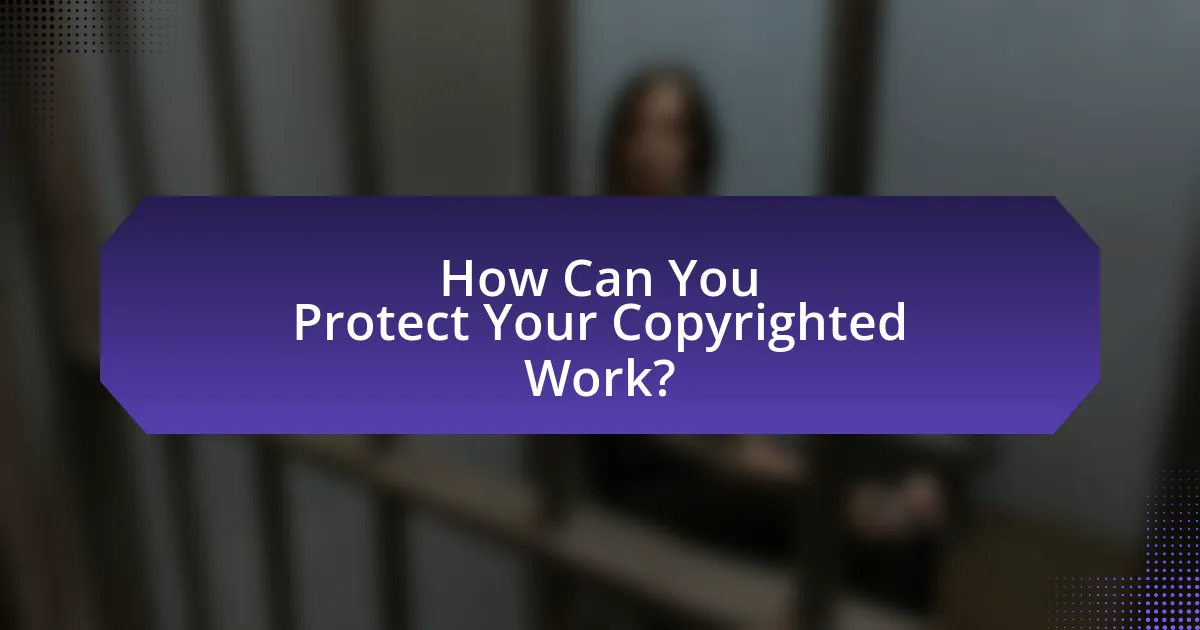
How Can You Protect Your Copyrighted Work?
To protect your copyrighted work, you should register it with the U.S. Copyright Office, as registration provides legal evidence of ownership and the ability to sue for infringement. Registration can be completed online and typically requires a completed application form, a nonrefundable filing fee, and a copy of the work. According to the U.S. Copyright Office, registered works are eligible for statutory damages and attorney’s fees in case of infringement, which reinforces the importance of this step in safeguarding your intellectual property.
What steps should you take to register your copyright?
To register your copyright, you must complete the following steps: first, prepare your work for registration, ensuring it is fixed in a tangible medium. Next, fill out the appropriate application form provided by the U.S. Copyright Office, which can be done online or via mail. After completing the form, submit it along with the required filing fee, which varies depending on the type of work being registered. Finally, include a copy of your work as a deposit, which is necessary for the registration process. The U.S. Copyright Office processes these applications, and upon approval, you will receive a certificate of registration, which serves as legal proof of your copyright.
How do you complete the copyright registration process?
To complete the copyright registration process, you must fill out the appropriate application form provided by the U.S. Copyright Office, pay the required fee, and submit a copy of the work you wish to register. The U.S. Copyright Office offers online registration, which is typically faster and less expensive than paper submissions. According to the U.S. Copyright Office, registering your work provides legal benefits, including the ability to sue for infringement and eligibility for statutory damages.
What information is required for copyright registration?
To register a copyright, the required information includes the title of the work, the name of the author, the date of creation, and a description of the work. Additionally, the applicant must provide the type of work being registered, such as literary, musical, or visual art. This information is essential for the U.S. Copyright Office to process the registration and establish the ownership of the work. Accurate and complete information ensures that the copyright is properly recorded and protected under the law.
How can you enforce your copyright rights?
To enforce your copyright rights, you can take legal action against infringers by sending a cease-and-desist letter or filing a lawsuit. Copyright law grants you the exclusive right to reproduce, distribute, and display your work, and if someone violates these rights, you can seek remedies such as monetary damages or injunctions. According to the U.S. Copyright Office, registering your work enhances your ability to enforce your rights, as it allows you to sue for statutory damages and attorney’s fees in case of infringement.
What are the best practices for monitoring copyright infringement?
The best practices for monitoring copyright infringement include utilizing automated tools, conducting regular online searches, and engaging with copyright monitoring services. Automated tools, such as digital fingerprinting and web crawlers, can efficiently scan the internet for unauthorized use of copyrighted material. Regular online searches on platforms like Google and social media can help identify potential infringements. Engaging with copyright monitoring services, which specialize in tracking and reporting copyright violations, provides an additional layer of protection. These practices are supported by the increasing prevalence of digital content theft, with studies indicating that over 80% of copyrighted content is shared without permission online.
How can you issue a cease and desist letter?
To issue a cease and desist letter, you must draft a formal document that clearly states the infringing activity, identifies the parties involved, and demands that the infringer stop the specified actions. The letter should include details such as the nature of the infringement, the legal basis for your claim, and a deadline for compliance. It is essential to send the letter via a method that provides proof of delivery, such as certified mail, to ensure that the recipient receives it. This process is supported by legal precedents that affirm the effectiveness of cease and desist letters in resolving disputes before escalating to litigation.
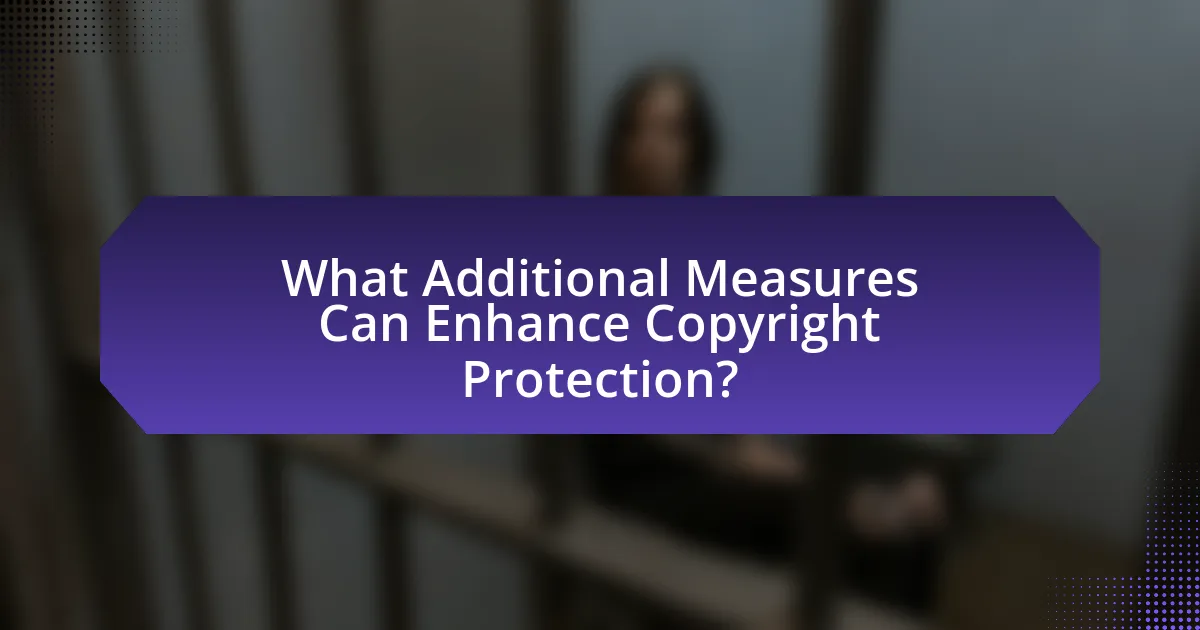
What Additional Measures Can Enhance Copyright Protection?
Implementing technological measures such as digital rights management (DRM) can significantly enhance copyright protection. DRM technologies restrict unauthorized access and copying of digital content, thereby safeguarding the rights of creators. For instance, the use of encryption and watermarking can deter piracy by making it more difficult to reproduce or distribute copyrighted material without permission. Additionally, legal measures such as stronger enforcement of copyright laws and international treaties can provide a more robust framework for protecting intellectual property across borders. According to the World Intellectual Property Organization, countries that adopt comprehensive copyright laws and actively enforce them see a reduction in copyright infringement cases.
How can you use digital tools to protect your work?
You can use digital tools to protect your work by employing copyright registration services, digital rights management (DRM) software, and watermarking techniques. Copyright registration services, such as those provided by the U.S. Copyright Office, legally establish ownership and provide legal recourse in case of infringement. DRM software restricts unauthorized access and distribution of digital content, ensuring that only authorized users can view or use the work. Watermarking, which embeds identifying information into digital files, deters unauthorized use and helps trace the source of any unauthorized copies. These methods collectively enhance the security and integrity of your copyrighted work in the digital landscape.
What role do watermarks and metadata play in copyright protection?
Watermarks and metadata serve crucial roles in copyright protection by providing identifiable markers and embedded information that assert ownership and usage rights. Watermarks, which can be visible or invisible, deter unauthorized use by making it clear that the work is protected, while metadata contains details such as the creator’s name, copyright status, and usage restrictions, which can be used to trace ownership and enforce rights. Studies show that the presence of watermarks significantly reduces the likelihood of unauthorized reproduction, as they act as a deterrent and a means of identification, reinforcing the legal claims of copyright holders.
How can you leverage technology to track unauthorized use?
You can leverage technology to track unauthorized use by implementing digital rights management (DRM) systems, which monitor and control access to copyrighted content. DRM technologies, such as watermarking and encryption, allow creators to embed unique identifiers in their work, making it easier to trace unauthorized copies. For instance, a study by the International Intellectual Property Alliance indicates that the use of DRM can reduce piracy rates by up to 30%. Additionally, utilizing analytics tools can help track user engagement and identify unusual access patterns, further aiding in the detection of unauthorized use.
What are the benefits of using licensing agreements?
Licensing agreements provide several benefits, including the ability to generate revenue while retaining ownership of intellectual property. By allowing others to use copyrighted material, creators can monetize their work without relinquishing control. For instance, licensing agreements can lead to increased exposure and market reach, as third parties promote and distribute the licensed content. Additionally, these agreements can foster collaboration and innovation, enabling creators to leverage the resources and expertise of licensees. According to a study by the International Licensing Industry Merchandisers’ Association, the licensing industry generated over $280 billion in retail sales globally in 2020, highlighting the financial potential of effective licensing strategies.
How do licensing agreements work in protecting your rights?
Licensing agreements protect your rights by legally granting permission to others to use your copyrighted work under specified conditions. These agreements outline the scope of use, duration, and any compensation involved, ensuring that your intellectual property is not exploited without your consent. For instance, a licensing agreement can specify that a publisher may reproduce your written work in exchange for royalties, thereby safeguarding your financial interests and maintaining control over how your work is distributed. By clearly defining the terms, licensing agreements help prevent unauthorized use and infringement, reinforcing your ownership rights.
What types of licenses can you offer for your work?
The types of licenses that can be offered for work include exclusive licenses, non-exclusive licenses, and creative commons licenses. Exclusive licenses grant one party the sole rights to use the work, while non-exclusive licenses allow multiple parties to use the same work simultaneously. Creative commons licenses provide a flexible range of protections and freedoms for authors, allowing them to specify how others can use their work. These licensing options are essential for protecting copyrighted work, as they define the terms under which the work can be used and shared, ensuring that the creator retains control over their intellectual property.
What are some best practices for protecting your copyrighted work?
To protect your copyrighted work, register it with the U.S. Copyright Office, as registration provides legal advantages, including the ability to sue for infringement and eligibility for statutory damages. Additionally, use copyright notices on your work to inform others of your ownership and the date of creation, which can deter unauthorized use. Maintain thorough records of your work’s creation process, including drafts and correspondence, to establish ownership and originality. Finally, consider using digital rights management (DRM) tools to control how your work is distributed and accessed online, further safeguarding against unauthorized use.
How can you educate yourself about copyright laws and updates?
To educate yourself about copyright laws and updates, you can utilize reputable online resources, attend workshops, and follow legal blogs. The U.S. Copyright Office provides comprehensive information on copyright laws, including updates and guidelines, which can be accessed through their official website. Additionally, organizations like the American Bar Association offer seminars and publications that cover recent changes in copyright legislation. Engaging with these resources ensures that you stay informed about the evolving landscape of copyright law.
What resources are available for copyright protection assistance?
Resources available for copyright protection assistance include the U.S. Copyright Office, which provides information on copyright registration and enforcement. Additionally, organizations such as the American Bar Association offer resources and legal guidance on copyright issues. Nonprofit groups like Creative Commons provide tools for licensing and sharing creative works while maintaining copyright protection. Furthermore, online platforms like Copyright.gov offer educational materials and FAQs to help individuals understand their rights and the registration process. These resources are essential for creators seeking to protect their intellectual property effectively.
